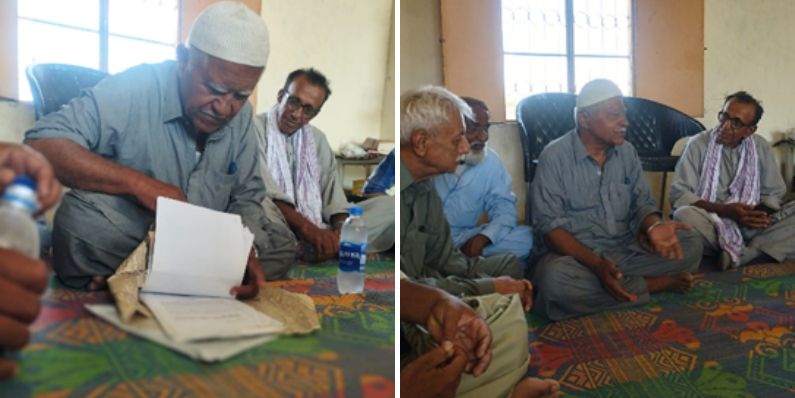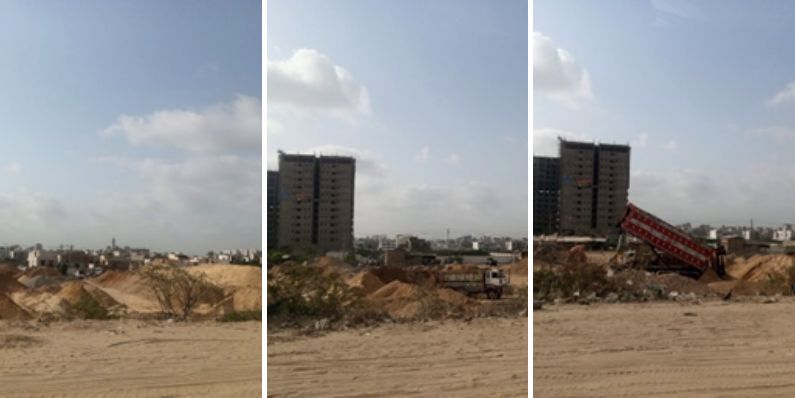Sand mining and environmental degradation in the Malir River: The dark side of development
A reflection by Zia ur Rahman
Field visits are a great way to understand how one environmental problem is related to the other. During our visit to the Malir Expressway construction site, not only did we visit farms and libraries that will serve as a site to the expressway, but we also learned about sand mining in the Malir river itself. Sand, also known as raiti/bajri, is being illegally extracted from the Malir area and sold in different areas of Karachi posing severe environmental risks to the riverbed.
 Figure 1: Chacha Siddique showing us the stay orders he received from the court and endorsements from EPA to make sure sand mining is stopped in Malir River
Figure 1: Chacha Siddique showing us the stay orders he received from the court and endorsements from EPA to make sure sand mining is stopped in Malir River
A local resident Mohammed Siddiqui from Dur Mohammed Goth, Darsano Chano, has been actively protesting against the unauthorized excavation of sand and gravel in his village and surrounding areas, including Usman Goth, Deh Bazu, Deh Malh, Deh Thno, Deh Khokhar, and Deh Sango, all situated along the riverbank. Siddiqui's relentless efforts led him to file a case in the Sindh High Court, which he eventually won in 2012. The court issued an order to immediately halt the extraction of raiti/bajri. However, despite the court's clear order against it, the illegal sand mining continues unabated.
The Consequences of Unregulated Sand Mining
The uncontrolled extraction of sand has severe consequences for both the environment and local communities. According to Siddiqui, the continuous lifting of raiti and bajri has significantly lowered the groundwater level from 80 feet to a staggering 300 feet over the years. Overextraction of ground water might play a part but the sand structure is important for recharging the groundwater. This drastic decline in the water table poses a significant threat to the entire irrigation system in the area, which is now heavily reliant on sewage water due to the depletion of natural water sources.
Moreover, the excavation activities are causing ecological imbalance and putting local biodiversity at risk as well as impacting environmental flows. The delicate balance of the ecosystem is being jeopardized, leading to long-term environmental degradation.
 Figure 2: Sand from the river bed being transferred to construction sites
Figure 2: Sand from the river bed being transferred to construction sites
Questionable Practices and Ineffective Enforcement
The illegal sand mining operations seem to be thriving due to the alleged collusion between contractors and local law enforcement authorities. Siddiqui and other affected community members have accused the contractors of excavating minerals in connivance with the police, bypassing legal requirements and disregarding the court's order.
Despite the valiant efforts of Siddiqui and the court's warnings to the concerned authorities, the sand mining activities persist. The lack of effective enforcement and monitoring mechanisms has allowed this environmentally damaging practice to continue, posing a grave threat to the local environment, communities, and natural resources.
The issue of sand mining near the Malir Expressway construction site highlights the urgent need for severer regulations and enforcement to protect the environment and ensure the well-being of local communities. The unabated extraction of raiti/bajri not only disrupts the ecological balance and depletes groundwater resources but also demonstrates a disregard for legal obligations and court orders.
It is essential for the relevant authorities to take immediate action and halt these illegal sand mining activities. The media also plays a crucial role in raising awareness and reporting such violations to ensure that developments detrimental to the environment are brought to the court's attention. By addressing the issue of sand mining, we can safeguard the ecological integrity of the area and uphold the principles of environmental justice and sustainability.
As an educator, I am motivated to learn and teach about these diverse issues to my students as well as work towards systems change alongside my local activism.


